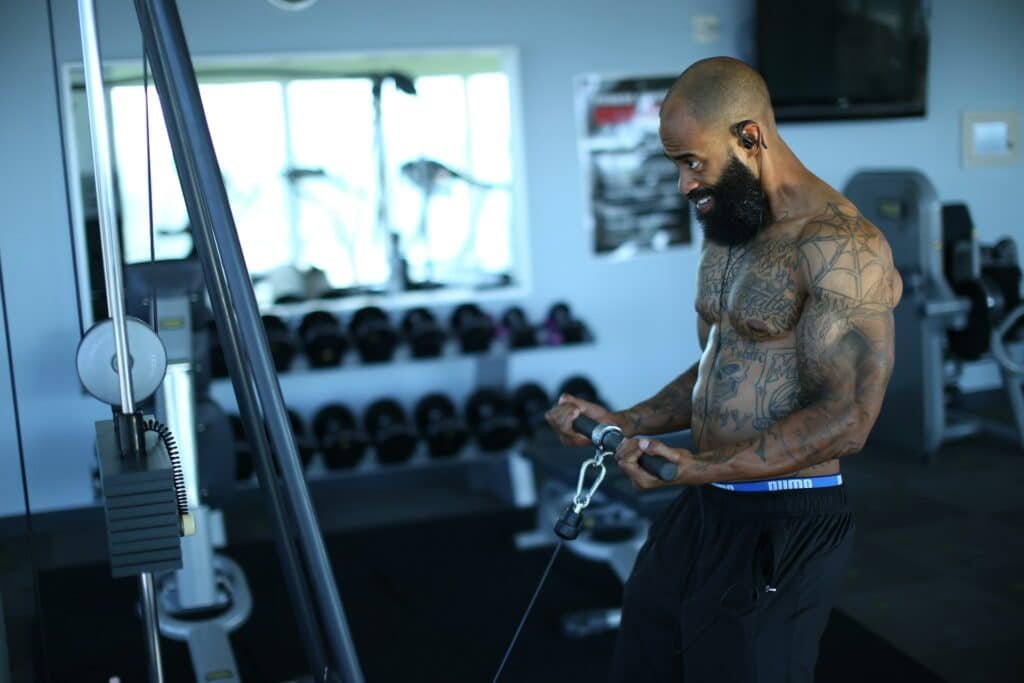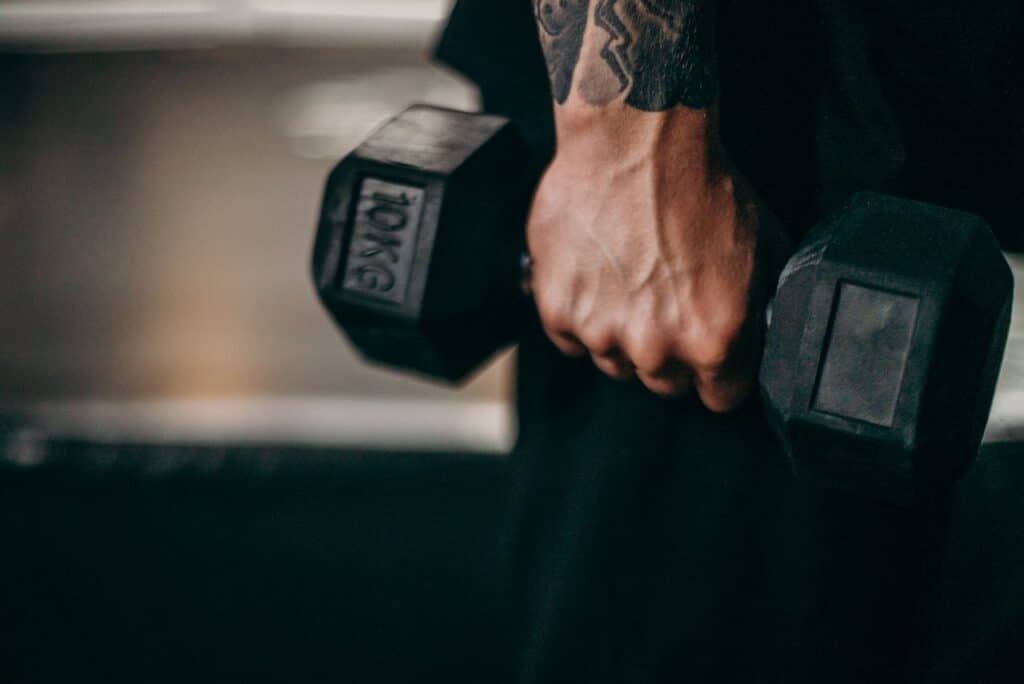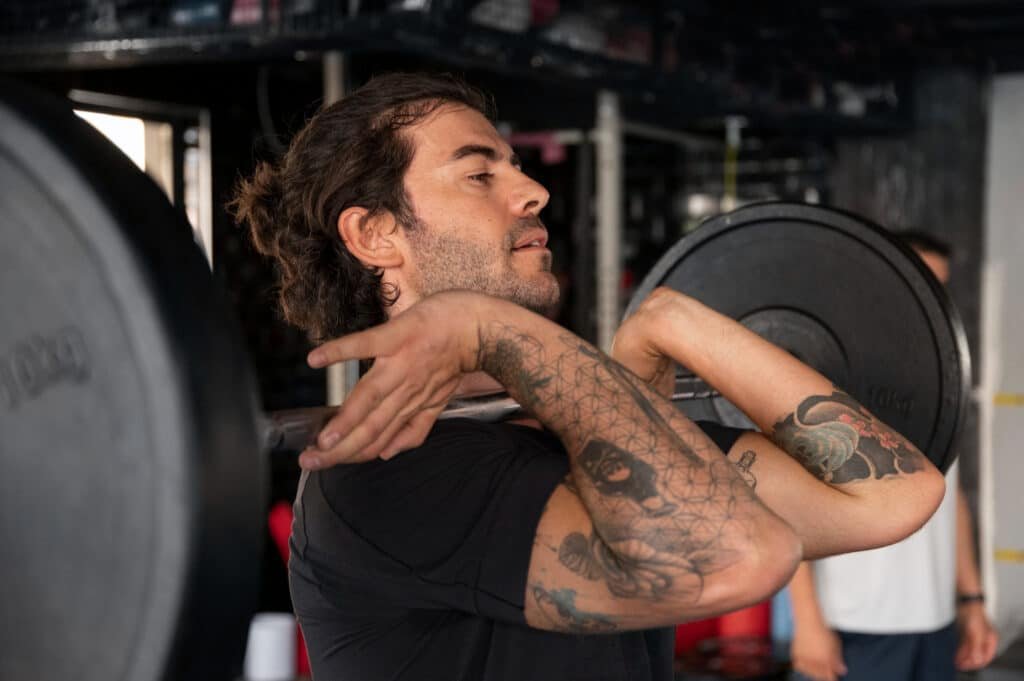Can I Workout After Getting a Tattoo? Expert Advice Inside

So you just got some fresh ink and you’re thinking, Can I workout after getting a tattoo?’ It’s a frequent question, especially if you work out a lot. Essentially, getting tattooed is opening a wound in our skin and it should be allowed time to heal.
Getting back at your regular routine too quickly can lead to issues, such as infections or screwing up of your fresh art.
We’re getting into what you need to know about hitting the gym or trails after fresh ink, so your body — and tattoo — can stay looking good.
Key Takeaways
- The new tattoo is an open wound, so it needs time to start healing before you sweat on it. Wait 48 hours before you need to shower, but ideally longer, especially for large tattoos with difficult-to-reach spots.
- Exercising too quickly can cause infection, smearing of ink or skin irritation. Gym equipment and sweat bacteria can really mess with your healing skin.
- Listen to your body. Stop if a move hurts or tugs on the tattooed area. You may have to change your routine depending on where and how big the tattoo is.
- For the first week or two, skip any activity that would make you sweat heavily or cause friction (like rigorous working out), not to mention submerging the tattoo in water (that includes swimming).
- Soft, low-impact exercise that does not place direct strain on the tattooed portion of your body could be O.K. sooner, but always ask your tattoo artist if you are uncertain.
Understanding Tattoo Healing and Exercise
A new tattoo can be an exciting time in your life, but it also means your skin has recently experienced some wear and tear that needs careful, yet-still-active treatment. Consider your fresh ink an open sore for the first two weeks plus.
This is because jumping back into your normal workout routine too soon can actually mess with the healing process, and even mess with what your tattoo will look like on down the line.
It’s not just about guarding against discomfort, but also the integrity of the artwork and possible complications. Your body must heal the skin and get that ink settling in there right.

If you know the primary phases of tattoo recovery, you can better determine when it’s alright to return to sweating again. Typically, the most delicate 2 to 4 weeks are in the beginning stage of healing when tattoo is at risk of infection and other complications. Your skin is meanwhile doing all it can to close up and grow back.
Here’s a quick look at what’s happening:
- Day 1-3: The tattoo will likely be red, swollen, and might ooze a bit. This is when it’s most like an open wound.
- Day 4-14: The redness and swelling should decrease. You might experience itching and some peeling, which is totally normal.
- Week 2-4 (and beyond): The outer layers of skin are healed, but the deeper layers are still settling. This is when you can start to gradually reintroduce exercise, but still need to be mindful.
At this point, it’s seriously important that you treat your tattoo with care. Keeping it clean and moisturized is crucial, but so is following the aftercare instructions your artist swears by. You can also visit tattoo aftercare instructions for more information on general tattoo aftercare.
Why Exercise Can Be Risky After a Tattoo
There’s the exuberance of getting a new tattoo — and also the fact that essentially you’re wounded during its healing. That’s why a too-quick return to your regular workout routine can be a little risky. After all, you do not want to mess with the recovery, right?
Increased Risk of Infection
Consider that new tattoo of yours as a weak spot for germs to enter. Sweat, rubbing from clothing and direct contact with gym equipment can also bring bacteria. If they get into the tattooed skin, it can cause an infection. Signs of infection may be redness, swelling or pus, and in some cases fever. Stick to environments in which you can avoid unsanitary surfaces or prolonged exposure to moisture.
Potential for Ink Smudging or Fading
Though uncommon when done with up-to-date techniques, the stretching or friction of skin while doing physical activities can disrupt tattoo ink and prevent healing. There is some risk of ink displacement if the skin is constantly stretched or rubbed, especially for the first few days. This can make the tattoo not look as sharp, and perhaps even eventually lead to some fading. But it is a matter of getting that ink to settle in there perfectly.
Irritation and Inflammation
You get hot and sweaty during exercise, with the latter resulting from your body trying to cool itself. For a fresh tattoo, it might irritate and inflame more. The tattoo might appear redder, more swollen or feel more tender than normal. Doing too much can cause the healing time to take longer and make your whole experience more uncomfortable. It might be best to take it easy and not apply any pressure to the area by doing some lighter activities at first so as to keep everything calm, let it heal itself, without having too much added stress.
How Long Should You Wait to Exercise?

So you’ve got some fresh ink and it suddenly dawns on you: How soon can I go back to the gym? It’s a question they get often and the answer is not as straightforward as, say, one-size-fits-all. Your body requires recovery, and that freshly inked tattoo is basically an open wound for some time. Returning to your normal routine too quickly could lead to issues, such as getting an infection or messing with the way your tattoo looks.
Also Read: Nicola Coughlan Weight Loss & Transformation
General Guidelines for Different Activities
Most tattoo artists and dermatologists advise waiting at least 48 hours before beginning any sort of physical activity. But that’s just the beginning. It all comes down to what type of exercise you’re doing and where your tattoo is placed.
Light Activity: A for little things like a leisurely stroll you might be in the clear after a few days, especially if your tattoo isn’t anywhere it will get jostled around too much. You just need to keep it clean and dry.
Moderate Activity: For workouts that leave you sweating a bit more — cycling or moderate weightlifting, for example — it’s best to wait at least a week. That allows the surface layer of your skin to close up.
Strenuous Activity: High-impact sports, weightlifing and activities that require heavy lifting or a high degree of friction around the tattooed area should be off-limits for at least two to four weeks. This could be activities such as running, HIIT or contact sports.
Factors Influencing Healing Time
There are a few factors that can influence how long you should actually wait before getting back to your workouts:
Size and Complexity: Smaller, simpler tattoos composed mostly of line work and dots tend to heal faster than larger, more complex pieces with shading or color. *A large back piece requires more time to heal than a small wrist tattoo.
Where You Get Your Tattoo: Shifting areas like elbows, knees, armpits or your torso will need a longer healing time. The continuous activity may irritate the newly-healed skin and could possibly disturb the ink.
Your Body’s Healing Your: Everyone recovers at a different pace. If you are a quick healer, maybe sooner. And on the flip side, if you generally heal more slowly, then allow yourself extra time.
Sweat Factor: Excessive sweating may be a concern as sweat not only irritates recently done tattoos, but also carries the risk of bacteria. If you’re very aware that you sweat a lot while working out, you may need to wait longer than three days or be more vigilant about cleaning the tattoo right after exercise. Activities that produce heavy sweating for a few days should be avoided, though this is often advised.
Better to be safe than sorry. If that doesn’t, though, check with your tattoo artist. They are familiar with the details of your tattoo and can give you the best advice based on your circumstances. Don’t hurry it along; a touch of patience now will spare you a good deal of stress later. Your tattoo will be happier for it.
Safe Exercise Practices During the Healing Process
So, you’ve gotten some fresh ink and are dying to get back to your workout routine. That’s totally understandable! But before you head right back into the thick of things, there’s one really important thing you should keep in mind: be smart about it. Imagine your new tattoo like a fragile piece of art that requires special handling while it’s healing. What we want here is to let it heal right and not create additional stress and/or irritation.

Why you should wait to workout for at least a few days
I think resting your body after the trauma of getting a tattoo is crucial. Your skin is essentially an open wound the moment you finish getting pricked and applying sweat, friction, or gym bacteria can seriously muck up the healing process.
“Waiting at least 24 to 48 hours, and in some cases even longer depending on the tattoo and your body, allows all of those little channels in the top layers of skin to start closing up,” Mayer says, “and that initial protective layer begins forming.” This time in limbo mitigates the chance of infection and protects ink from getting abused before it has truly had a chance to take hold. Better to be a tiny bit patient now than needlessly put your new tattoo at risk or suffer complications later.
How to workout after a tattoo
Sets that apprentices must complete before beginning specified hours. The key is to be gentle on the tattooed area. Here’s how to approach it:
The golden rule: “Listen to your body. If something feels wrong, or any exercise causes any type of discomfort or pulling on your tattoo, don’t do it. Don’t push through pain.
Change things up a little: You may have to modify your normal workouts. If your tattoo is on your arm, perhaps lay off the heavy bench presses or pull-ups for a week or so. If it’s on your leg, maybe ease up on running and jumping for a bit, or take a break in favor of cycling or swimming (once recovered from full water submersion).
Clean it up: Never forget to wipe down gym equipment both before and after using, especially if it could potentially touch your tattoo. Wash your hands well before and after you work out.
Loose is better: Wear soft, non-restrictive clothing that lets your tattoo breathe, and won’t chafe or adhere to it. Friction and moisture can be caused by tight clothing, which is not good.
Wash your tattoo after working out: Once you can, carefully clean the area around your new tattoo with a mild fragrance- and alcohol-free soap and lukewarm water. Pat it dry with fresh paper towels — no need to rub. Then, you can use a light application of your artist’s favourite aftercare product.
Don’t forget: You’re trying to protect your new ink here. Consider low-impact activities that don’t exert direct pressure or friction on the tattooed area. It’s all about being patient and letting your body work its magic.
Here’s a quick rule of thumb to tell you when some activities should start becoming safe — individual healing times may vary, however:
| Activity Type | Initial Waiting Period | Considerations |
|---|---|---|
| Light Cardio (walking) | 24-48 hours | Avoid friction from clothing; ensure the area stays clean and dry. |
| Strength Training | 3-7 days | Avoid exercises that strain or rub the tattooed area. Use lighter weights if necessary. |
| Yoga/Pilates | 3-7 days | Be mindful of stretches that pull on the tattooed skin; avoid positions that put pressure on the area. |
| Swimming/Hot Tubs | 2-4 weeks | Avoid prolonged immersion in water until the tattoo is fully healed and no longer scabbing or peeling. |
| High-Impact Sports | 2-4 weeks | Avoid activities with a high risk of impact, friction, or excessive sweating directly on the tattoo. |
If you have any particular concerns, ask your artist about it during the post-appointment consultation or when it’s safe to return back to your usual workout regimen.
Types of Exercises to Avoid After Getting a Tattoo

So you’ve got some new ink and you’re raring to return to your typical fitness routine. That’s totally understandable! But even before you head back to your high-octane workouts, it’s crucial to be clear about which exercises are a no-go for awhile. Just consider it this way: your new tattoo is essentially a gash, you wouldn’t fuck with that stuff would you?
How long until you can do cardio workouts after you get a tattoo
Cardio is a bit more of a mixed bag. For some light cardio, like a brisk walk or a little bit of easy cycling (just no friction), you may be able to start after several days, so long as there’s no excessive sweating directly on the tattooed area. But anything that really gets you drenched in sweat or has a lot of bouncing or friction, or movement around the tattoo, should have more time.
HIIT, sprinting, or long-distance running are in general not suitable for the first 2-3 weeks or until your tattoo isn’t an open wound anymore. The sweat can irritate the spot, and the back and forth of your body in motion can cause quite a bit of friction, both things that nobody wants to mess with their healing skin or ink.
Best Practices for Working Out with a Healing Tattoo
Even as you do get back to exercising, even in a modified way, here are a few things to keep in mind:
Keep it Clean: Remember to always wash your hands before and after a workout. If you’re working with gym equipment, make sure to wipe it down well. After your session WASH, the tattoo with mild unscented soap (not anti-bact-erial) and warm water. Pat the meat dry with a clean paper towel — don’t rub!
Stay Hands-Free: See if you can wear loose clothes that won’t touch your new tattoo. If your tattoo is on your leg, you might not slap on the tight leggings for a while. If it’s on your arm, stay away from sleeves that might catch or annoy it.
Listen to Your Body (and Heart): This is the most crucial rule. If any exercises are uncomfortable, sting at the tattooed region or make you feel that it is pulling, stop. Precaution is better than cure.
Hydration: Hydration is great for the general healing and well-being but watch out about sweating. If you’re a heavy sweater, wash your tattoo sooner rather than later.
How long until I can do CrossFit workouts after I get a tattoo?
CrossFit is a game changer all together, man. Since CrossFit often combines intense cardio, heavy lifting, and dynamic movements, you may need to wait quite a bit. Consider at least three to four weeks, if not a bit longer, depending on the body location or how you’re healing.
Activities like burpees, pull-ups, or anything that feels stretchy or friction follows suit: hold off for now. If your tattoo will be in a place on your torso, back or mostly used limbs that will see heavy use with those movements, and may also be an area that gets heavily sweaty when you do them as well, then wait longer.
It’s mainly about allowing the skin sufficient time to close and move through its deeper healing stages before exposing it to that level of stress.
In general, activities that cause extended friction, stretching of the tattooed skin, or prolonged submersion in water (such as swimming pools and hot tubs) should be avoided until your new ink has healed. This is typically after the flaky, scabby stage has passed and your skin feels smooth once more — two to four weeks, or sometimes even longer.
Wrapping Up Your Post-Tattoo Workout Plan
So, you’ve just got this cool new tattoo and you’re finally ready to hit the gym. Just keep in mind that new ink is essentially a fresh wound for a bit. Such an important step that needs to be given the time it deserves to heal properly.
Pay attention to your body, take it easy, and yes, listen to the advice of your artist. With a little patience now, the tattoo will look fantastic for years to come and you’ll be able to get back on the grind of crushing your fitness goals without any worries. Keep it dirty and active and have fun with your new art!
FAQs
How long after getting a tattoo can i workout?
In general, it’s best to wait 48 hours — or your artist’s recommended post-tattoo wait time — before touching the area with work out enthusiasm. For larger or more complicated tattoos, or if your own tattoo is in a place that gets a lot of movement, you might need to wait even longer — think three weeks. Now remember to always listen to your body – if it hurts, do not do it!
Is it okay to sweat after getting a tattoo?
It’s not a good idea to sweat too much so soon after getting a tattoo since sweat can harbor germs that might find their way into your healing skin. For the next few days, try to stay away from really sweaty workouts. If the activity is so light that you do sweat a little, be sure to clean and gently dry your tattoo right after.
Will working out change my tattoo?
Your tattoo essentially isn’t going to change all that much from working out for the most part. But if you gain a large amount of muscle or weight very rapidly, the skin can stretch slightly — possibly altering how your tattoo looks. This is often not very good except the tattoo’s extremely large or in a fluctuating size area.
Can I workout 1 week after getting a tattoo
It is probably best, to wait at least 2 weeks before starting heavy working out but light exercise 1 week after the tattoo, if it healing very well might be OK Just avoid sweat and stretch or friction on that area.
When should I stop exercising and see a doctor about my tattoo?
Your tattoo area is much more painful, swells up a lot after you stop exercising, looks really red or you see anything weird coming out: You should stop your workout and see a doctor. A fever or red lines that spread from the tattoo are also signs that something could be wrong and warrants medical attention.



